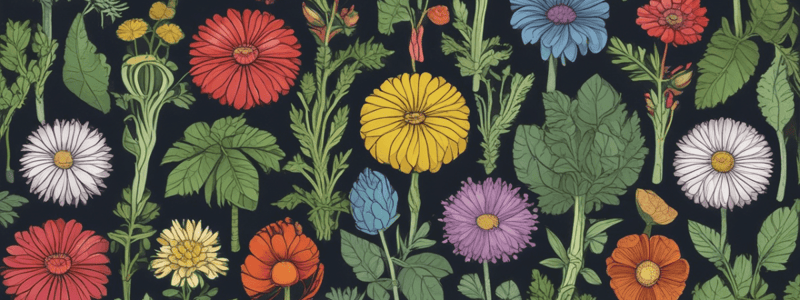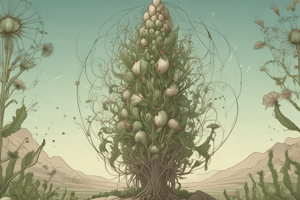Podcast
Questions and Answers
Which of the following is considered a key evolutionary advantage of seed plants over spore-bearing plants?
Which of the following is considered a key evolutionary advantage of seed plants over spore-bearing plants?
- The ability to produce larger plants
- The ability to produce more spores
- The ability to reproduce sexually
- The ability to stop the developmental clock and survive harsh conditions (correct)
What is the role of the integument (seed coat) in seed plants?
What is the role of the integument (seed coat) in seed plants?
- It protects and provides food for the embryo (correct)
- It produces the male gametophytes (pollen grains)
- It is responsible for dispersing the seed
- It develops into the female gametophyte
Which of the following is a key difference between the female gametophytes of gymnosperms and angiosperms?
Which of the following is a key difference between the female gametophytes of gymnosperms and angiosperms?
- Angiosperms have a more reduced female gametophyte (correct)
- Gymnosperms have a larger female gametophyte
- Angiosperms have a more independent female gametophyte
- Gymnosperms have a more complex female gametophyte
Which of the following is a key difference between the male gametophytes (pollen grains) of gymnosperms and angiosperms?
Which of the following is a key difference between the male gametophytes (pollen grains) of gymnosperms and angiosperms?
Which of the following is a key evolutionary advantage of the development of fruits in angiosperms?
Which of the following is a key evolutionary advantage of the development of fruits in angiosperms?
Which of the four living groups of seed plants is most closely related to the angiosperms (flowering plants)?
Which of the four living groups of seed plants is most closely related to the angiosperms (flowering plants)?
What is a characteristic shared by all angiosperms according to the text?
What is a characteristic shared by all angiosperms according to the text?
Which plant group is known for being the tallest living vascular plant?
Which plant group is known for being the tallest living vascular plant?
From where do male gametophytes (pollen grains) develop in pines?
From where do male gametophytes (pollen grains) develop in pines?
What important product is NOT mentioned as a source from conifers?
What important product is NOT mentioned as a source from conifers?
In plant reproduction, what is the function of air bladders related to?
In plant reproduction, what is the function of air bladders related to?
Which plant group has only one living species remaining?
Which plant group has only one living species remaining?
What is the main distinguishing feature of angiosperms?
What is the main distinguishing feature of angiosperms?
Which of the following is NOT a genus of gnetophytes?
Which of the following is NOT a genus of gnetophytes?
What is the estimated age range for the origins of angiosperms, according to the text?
What is the estimated age range for the origins of angiosperms, according to the text?
Which of the following structures is a modified leaf that covers seeds and develops into fruit in angiosperms?
Which of the following structures is a modified leaf that covers seeds and develops into fruit in angiosperms?
What is a characteristic feature of gnetophytes, according to the text?
What is a characteristic feature of gnetophytes, according to the text?
What distinguishes gymnosperms from angiosperms?
What distinguishes gymnosperms from angiosperms?
Which process is responsible for pollen transfer in pines?
Which process is responsible for pollen transfer in pines?
What was a perplexing issue for Darwin regarding angiosperms?
What was a perplexing issue for Darwin regarding angiosperms?
How does passage through an animal digestive tract promote seed germination in angiosperms?
How does passage through an animal digestive tract promote seed germination in angiosperms?
What does the meiosis of the megaspore mother cell in angiosperms result in?
What does the meiosis of the megaspore mother cell in angiosperms result in?
What is the major factor distinguishing pines from other conifers?
What is the major factor distinguishing pines from other conifers?
What is the function of the integuments in the ovule?
What is the function of the integuments in the ovule?
Which process occurs in the megasporangium of seed plants?
Which process occurs in the megasporangium of seed plants?
What is the primary means of pollen transfer in pines?
What is the primary means of pollen transfer in pines?
Which phylum includes firs, cedars, cypresses, spruces, and pines?
Which phylum includes firs, cedars, cypresses, spruces, and pines?
What distinguishes gymnosperms from pterophytes (ferns and allies)?
What distinguishes gymnosperms from pterophytes (ferns and allies)?
How does the gametophyte size in seed plants compare to their ancestors?
How does the gametophyte size in seed plants compare to their ancestors?
Study Notes
Seed Plants
- Evolved from spore-bearing plants (progymnosperms) 305-465 million years ago
- Success attributed to evolution of seeds, which protect and provide food for embryos
- Seeds allow plants to survive harsh periods before germinating
Types of Gametophytes
- Male gametophytes (pollen grains) dispersed by wind or pollinators
- Female gametophytes develop within an ovule, enclosed in diploid sporophyte tissue in angiosperms
Phyla of Extant Seed Plants
- Coniferophyta (conifers, e.g., pines, spruces, firs, cedars)
- Cycadophyta (cycads)
- Gnetophyta (gnetophytes, e.g., Ginkgo biloba)
- Anthophyta (flowering plants, angiosperms)
- Gymnosperms (plants with "naked seeds")
- Ferns and Allies (pterophytes)
Characteristics of Conifers
- Produce tough needle-like leaves in clusters
- Leaves have thick cuticle and recessed stomata to retard water loss
- Leaves have canals with resin to deter insect and fungal attacks
- Coastal redwood is the tallest living vascular plant
- Bristlecone pine is the oldest living tree
- Conifers are sources of important products (timber, paper, resin, and taxol)
Gnetophytes and Ginkgophytes
- Gnetophytes have vessels in their xylem
- Ginkgo biloba is the only living species of Ginkgophytes
- Flagellated sperm and dioecious male and female reproductive structures
Angiosperms (Flowering Plants)
- Ovules are enclosed in diploid tissue at the time of pollination
- Carpel, a modified leaf, develops into fruit
- Angiosperm origins are a mystery, with fossils dating back to 145-208 million years ago
Studying That Suits You
Use AI to generate personalized quizzes and flashcards to suit your learning preferences.
Description
Learn about the evolution of seed plants, their appearance 305-465 million years ago, and how they evolved from spore-bearing plants known as progymnosperms. Understand how the development of seeds and fruits contributed to their success and survival strategies.




